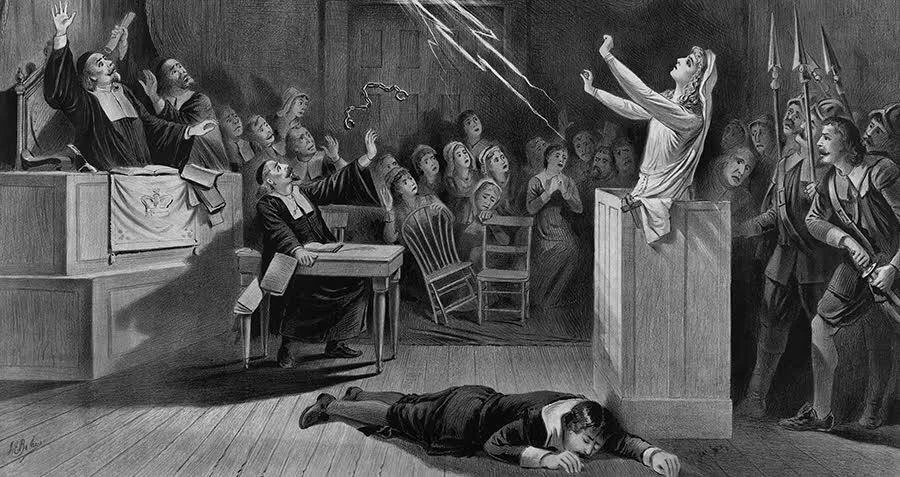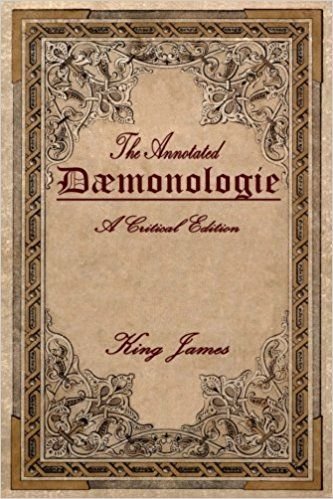Why the Scottish Witch Trials?
1597 was arguably the worst year for witch-trials, with estimates ranging from 200-400 executed - mostly women. I was first inspired to write about it when I came across the story of Marion Walker, a formidable woman who stood up to the authorities. A Catholic widow, living in Glasgow, she made it her business to be a stone in the shoe of zealous minister John Cowper (Cooper/Couper) - a thin-skinned man who decided mass murder was ‘God’s work.’ No apologies for the cynicism in my tone. The more I researched, the more appalled I became. Here are some facts:
A young woman accused of witchcraft by Puritan ministers appeals to Satan to save her
1597 was the year the King himself, James VI, published his book Daemonologie, sanctioning torture of suspects and burning of those deemed witches.
James wasn’t a popular king, having angered Catholics with the Reformation and Presbyterians by not going far enough with it, and just about everyone else with his deeply authoritarian regime. What better way to consolidate his own power than by stoking fear against a group without a voice? Nothing unites folk better than anger and hate. Echoes of modern-day politics? I wonder if James VI was one of history’s populists.
1597 was another in hard year, with failed crops, soaring prices, sickness, famine and the ever-present threat of plague. Citizens grew restless, James VI blamed witches. The Church followed suit. Ministers like Cowper agitated from their pulpits, urging neighbour to denounce neighbour.
The witch-scare started in Aberdeen and, egged on by church and king, case numbers grew fast. ‘Crimes’ included ‘making merrie with the de’il,’ casting spells to cause damage to property, ill-harm or death, changing into animal form… maleficium in general.
In Fife Margaret Aitken was arrested and sentenced to death. She saved herself by claiming she could spot another witch by a mark in their eye. Then she claimed to have had a dream, of 2,300 witches meeting in Atholl. That was enough to cause panic and Aitken - The Great Witch of Balwearie - was taken from burgh to burgh, spotting witches in their dozens. The pyres must have filled the skies with smoke, not to mention the cost of fuel…
And that gave me ideas. What did the sellers of fuel - peat and wood - think about their customers? They’d have have been economically lower-income, and I suppose that in the climate of the time, they might believe they were doing God’s work. After all, if both Crown and Church are telling you what truth is, why would you think differently? And what of Margaret Aitken? She’s painted as one of history’s villains, but doesn’t greater responsibility lie with the men who used her?
So now I had some fascinating characters for my book: Marion Walker, John Cowper, a peat-seller and Margaret Aitken. What I needed was a main protagonist.
Looking at records of the witch trials, it struck me that, though many people have done an amazing job compiling what’s there, there are more names missing than recorded. How terrible is that? Lives snuffed out and not even a line-entry in a ledger. I wanted a protagonist who would bring to life a woman of the day. Normal, as complicated as any of us, educated and brought up to believe in a mix of state-approved doctrine, and superstitions of the day. Jonet Mackie. A fictional character but everywoman of 1597. Married to Tom, a peat-seller. In a world where politics and religious zeal dictate how she lives, where accuser and accused might be the same person, where arrest is just a grudge or a misfortune away and where survival might come down to an old woman from Fife deciding whether or not to point her finger at you.
Here is the BBC article that started my obsession: The woman who stood up to a witch-hunt - BBC News
And another group that have inspired me, with their pursuit of truth: Scottish Witch Trials | Remembering the Accused Witches of Scotland
Daemonologie. Released 1597

